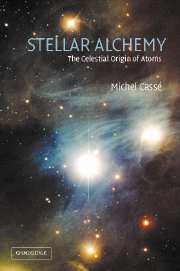Book contents
- Frontmatter
- Contents
- Preface
- Acknowledgements
- 1 Nuclear astrophysics: defence and illustration
- 2 Light from atoms, light from the sky
- 3 Visions
- 4 Contents of the sky: atomic sources and fountains
- 5 Nuclear suns
- 6 Sociology of stars and clouds
- 7 Histories
- 8 Ancient stars in the galactic halo
- 9 Conclusion
- Appendix 1 Invisible matter and energy
- Appendix 2 Supernovas and cosmology
- Appendix 3 Explosions
- Appendix 4 Stellar nucleosynthesis
- Appendix 5 Galactic evolution
- Appendix 6 Key dates
- Appendix 7 Constants and units
- Appendix 8 Websites
- Bibliography
- Index
4 - Contents of the sky: atomic sources and fountains
- Frontmatter
- Contents
- Preface
- Acknowledgements
- 1 Nuclear astrophysics: defence and illustration
- 2 Light from atoms, light from the sky
- 3 Visions
- 4 Contents of the sky: atomic sources and fountains
- 5 Nuclear suns
- 6 Sociology of stars and clouds
- 7 Histories
- 8 Ancient stars in the galactic halo
- 9 Conclusion
- Appendix 1 Invisible matter and energy
- Appendix 2 Supernovas and cosmology
- Appendix 3 Explosions
- Appendix 4 Stellar nucleosynthesis
- Appendix 5 Galactic evolution
- Appendix 6 Key dates
- Appendix 7 Constants and units
- Appendix 8 Websites
- Bibliography
- Index
Summary
Sources of the elements
In the eighteenth and nineteenth centuries, chemists had so successfully isolated the elements that John Dalton was able to put together a genuine atomic theory. Dmitri Mendeleyev organised the elements into his periodic table, the culmination of scientific elegance.
Confirming the idea of atomic structure, J.J. Thomson discovered the electron and Ernest Rutherford the atomic nucleus. When the nucleus was broken, Rutherford succeeded in distinguishing the proton, whilst James Chadwick identified the neutron. J.J. Thomson and his son G.P. Thomson each received the Nobel prize, the first for showing that the electron is a particle and the second for showing that it sometimes behaves as a wave. The discovery in France of natural radioactivity opened the way to the prospect of spontaneous transmutation. In doing so, it also demonstrated that the elements of the periodic table are not eternal. Pauli hypothesised the existence of the neutrino and it was discovered twenty years later. In the meantime, quantum physics had taken a firm hold of the atom and its nucleus, which became its favoured plaything. Nothing relating to the microcosmos escaped its notice or evaded explanation by the new theory.
Today, physical chemistry has accomplished its great task of elucidating the microcosmos. The existence, properties and combinatory rules for atoms have been firmly established. The problem now is to work out where they came from.
- Type
- Chapter
- Information
- Stellar AlchemyThe Celestial Origin of Atoms, pp. 51 - 76Publisher: Cambridge University PressPrint publication year: 2003



